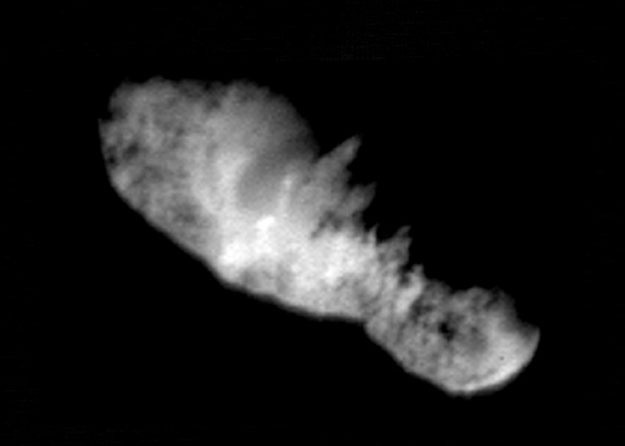Explanation: What does a comet nucleus look like? To answer this question, NASA controllers drove an aging probe through the hostile environs of a distant comet, expecting that even if comet fragments disabled the spacecraft, it would be worth the risk. The probe, Deep Space 1, survived. Pictured above is the most detailed image ever taken of a comet nucleus, obtained Saturday by Deep Space 1 and released yesterday by NASA. Comet Borrelly's nucleus is seen to be about 8 kilometers long with mountains, faults, grooves, smooth rolling plains, and materials of vastly different reflectance. Light colored regions are present near the center and seem to give rise to dust jets seen in Borrelly's coma, visible in distant images of the comet. Previously, the best image of a comet nucleus came from the Giotto mission to Comet Halley in 1986. Deep Space 1 images of Borrelly add welcomed bedrock to understanding Solar System history and to the accurate prediction of future brightness changes of notoriously fickle comets.
1999 2000 2001 2002 2003 2004 2005 2006 2007 2008 2009 2010 2011 2012 2013 2014 2015 2016 2017 2018 2019 2020 2021 2022 2023 2024 2025 |
Yanvar' Fevral' Mart Aprel' Mai Iyun' Iyul' Avgust Sentyabr' Oktyabr' Noyabr' Dekabr' |
NASA Web Site Statements, Warnings, and Disclaimers
NASA Official: Jay Norris. Specific rights apply.
A service of: LHEA at NASA / GSFC
& Michigan Tech. U.
|
Publikacii s klyuchevymi slovami:
kometa Borelli - comet Borrelly - Dip Speis-1 - Deep Space 1
Publikacii so slovami: kometa Borelli - comet Borrelly - Dip Speis-1 - Deep Space 1 | |
Sm. takzhe:
Vse publikacii na tu zhe temu >> | |
